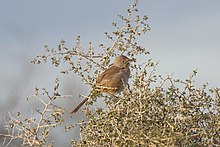Bendire's thrasher
| Bendire's thrasher | |
|---|---|
 |
|
| Scientific classification | |
| Kingdom: | Animalia |
| Phylum: | Chordata |
| Class: | Aves |
| Order: | Passeriformes |
| Family: | Mimidae |
| Genus: | Toxostoma |
| Species: | T. bendirei |
| Binomial name | |
|
Toxostoma bendirei (Coues, 1873) |
|
The Bendire's thrasher (Toxostoma bendirei) is a medium-sized species of thrasher native to the southwestern United States and northwestern Mexico. The Bendire's thrasher is 23–28 centimetres (9.1–11.0 in) long, with a long tail and a medium-sized bill. It is colored grayish-brown on its upperparts and has paler underparts with faint dark streaks. The base of the lower bill is often pale, the eyes are bright yellow, and the tips of the tail are white-tipped.
Because of its similar coloration and structure to the curve-billed thrasher, the two birds are very easy to mistake for one another. The Bendire's thrasher's shorter bill is a distinguishing feature when comparing mature birds, but it is still easy to misidentify an adult Bendire's thrasher as a young curve-billed thrasher as its beak has not grown to a mature length. The Bendire's thrasher's yellow eyes and pale-based lower mandible are additional markings which aid in separation from the Curve-billed thrasher.
The Bendire's thrasher lives in the brush-filled deserts and valleys and drylands of the south-western United States, mainly along the southern border that Arizona and New Mexico shares with Mexico, (the Madrean sky islands, mountain range sky islands of the northern Mexican range: Sierra Madre Occidental).
The Bendire's thrasher constructs a cup-shaped nest from twigs, lining the interior with grass stems and rootlets. It is usually placed in a cactus or an otherwise thorny desert shrub or tree. The female lays three or four eggs, which are pale green to blue in color, and speckled with brown and purple.
The Bendire's thrasher, like many other thrashers, feeds on small ground-dwelling insects as well as berries.
Like other mimids, the often silent Bendire's thrasher incorporates the songs and calls of other species into its own songs. A sharp "chek" is the species' most common call.
On July 28, 1872 U.S. Army Lieutenant Charles Bendire was hiking through the brushy desert near Fort Lowell, Arizona. While exploring the desert Bendire, an avid bird enthusiast, spotted a bird that was unfamiliar to him. Lieutenant Bendire shot the bird, which appeared to be a female thrasher, and sent its remains to the Smithsonian Institution in Washington, D.C.
...
Wikipedia

